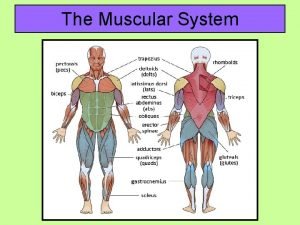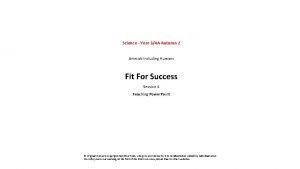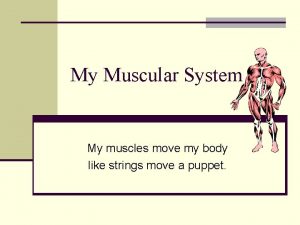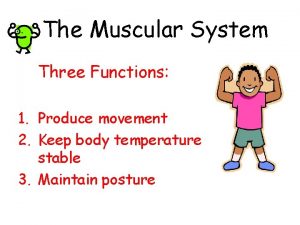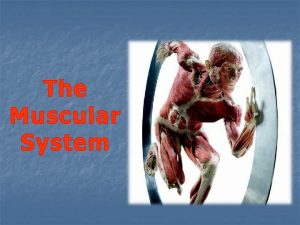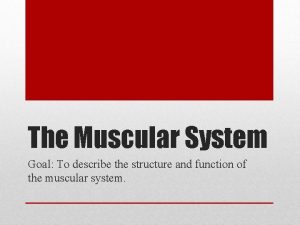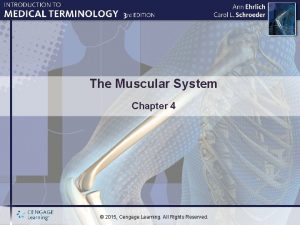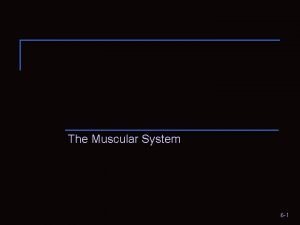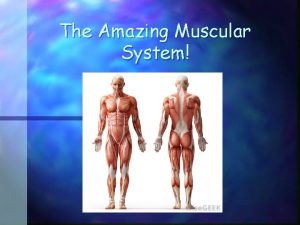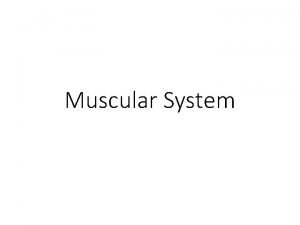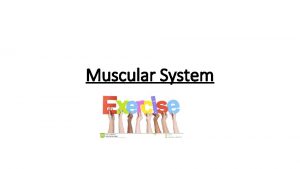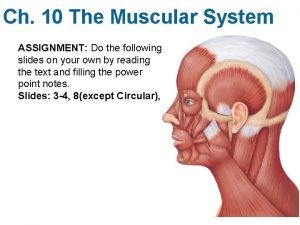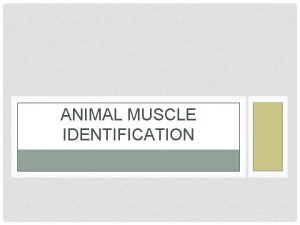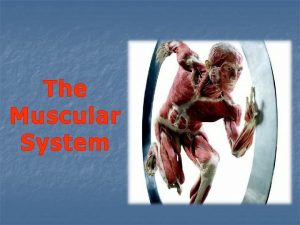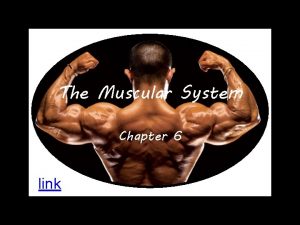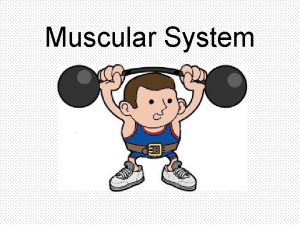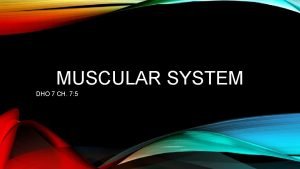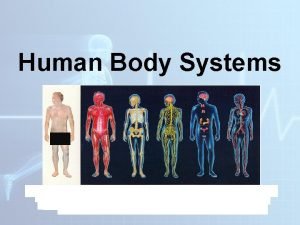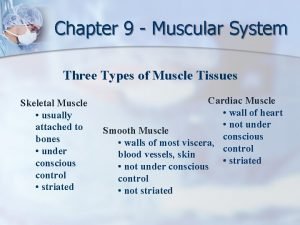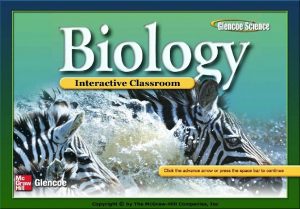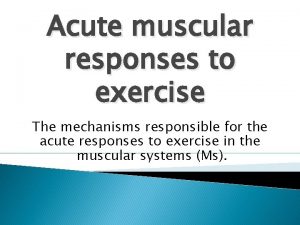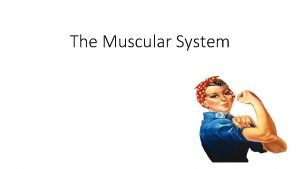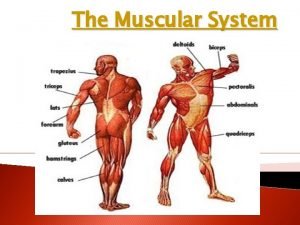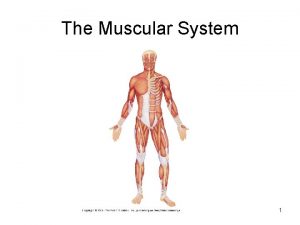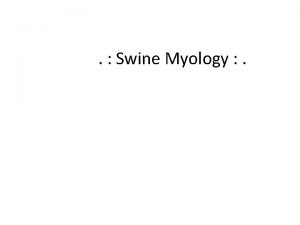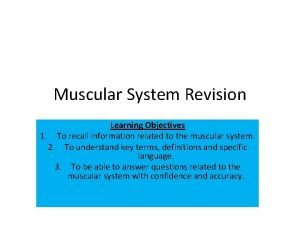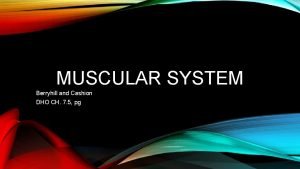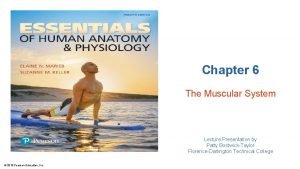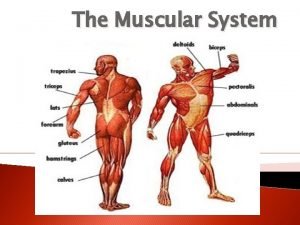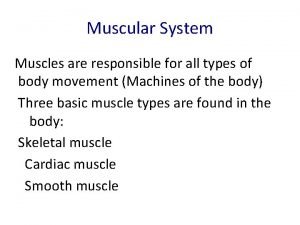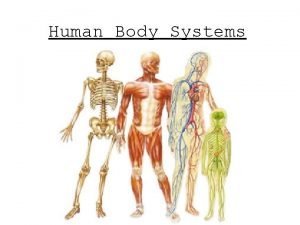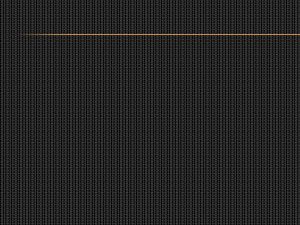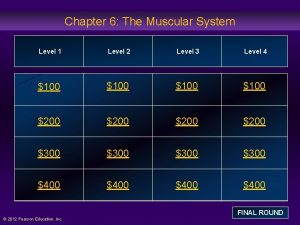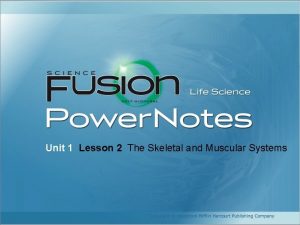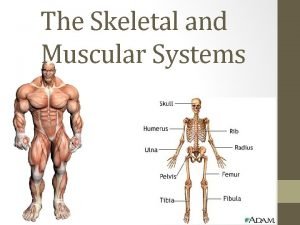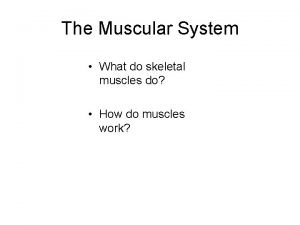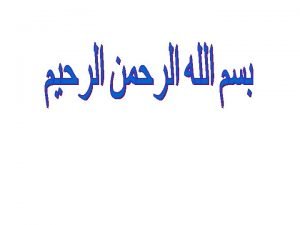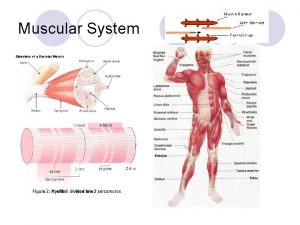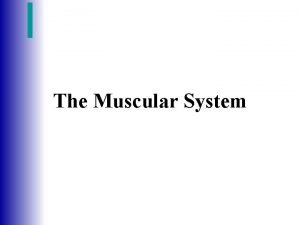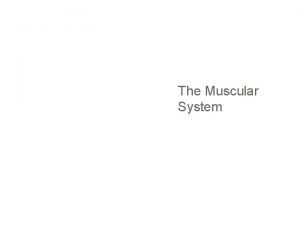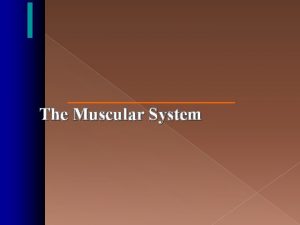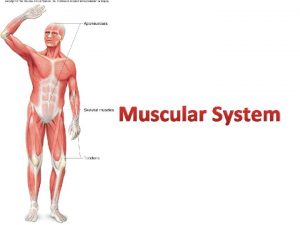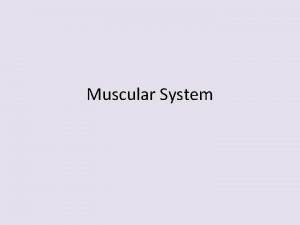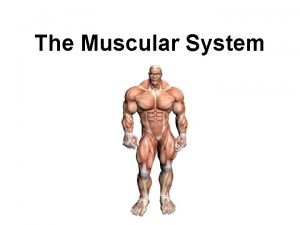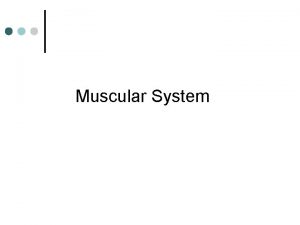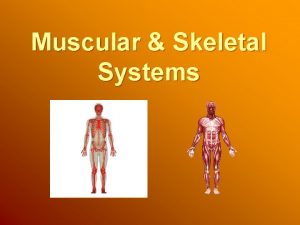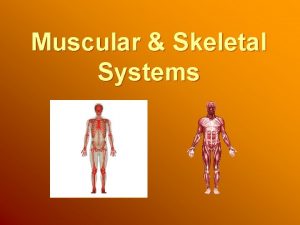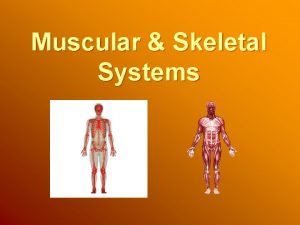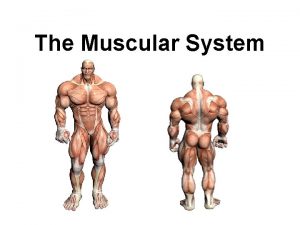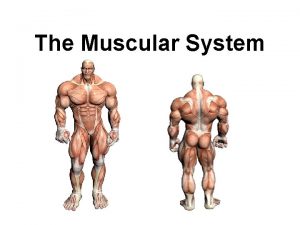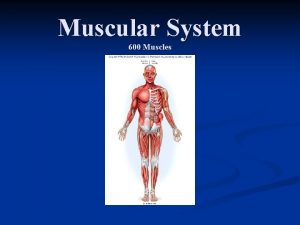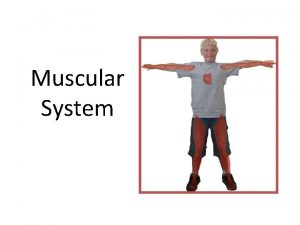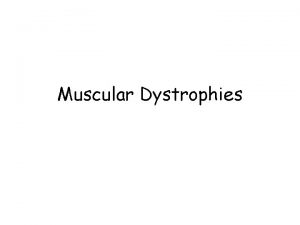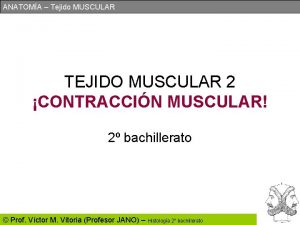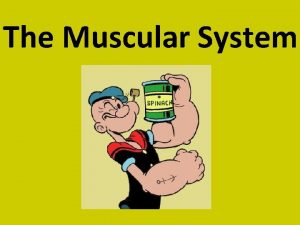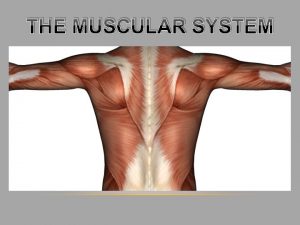The Muscular System Muscles 1 How many muscles















































- Slides: 47

The Muscular System

Muscles 1. How many muscles are there in the human body? 650 Muscles 2. How do muscles work? Muscles are bundles of muscle fibers held together by connective tissue. When the muscles contract, they pull on the tendons which pull on the bones causing our limbs to move.

Muscles • Muscles are either voluntary or involuntary. Consider your arm moving to write down class notes. You control this movement. VS. Your heart which beats 60 to 80 beats every minute without you having to think about it!

Characteristics of Muscle Excitability – response to nerve impulse Contractibility – fibers contract, becoming short and causing movement Extensibility – ability to be stretched Elasticity – returning to its original shape after being stretched

Functions of Muscles • • Attach to bones to provide movement Produce heat and energy Help maintain posture Protect internal organs

Types of Muscles q Cardiac q Visceral q Skeletal

Muscle Characteristics • A difference between skeletal and smooth muscles is that skeletal muscles are made of tissue fibers that are striated or striped (bands of light and dark). Smooth muscle fibers are not striated. • The cardiac or heart muscle (also called myocardium) is a unique type of muscle that does not fit clearly into either of the two classes of muscle. Like skeletal muscles, cardiac muscles are striated. But like smooth muscles, they are involuntary, controlled by the autonomic nervous system. Skeletal Smooth Cardiac

Cardiac and Visceral Muscles Cardiac Muscles Visceral Muscles form the walls of (smooth muscles) heart and contracts are found in internal to circulate blood organs such as the through out the digestive and body. respiratory systems. Also, these muscle are found in the eyes and blood vessels

Skeletal Muscles • Skeletal Muscles attach bones which causes body movement.

Involuntary Muscles • Both cardiac and visceral muscles are classified as involuntary muscles. These muscles function without our conscious control.

Voluntary Muscles • Skeletal muscles are classified as voluntary muscles because a person has control over its action.

Types of Attachments TENDONS: • Strong, tough connective tissue cord • EXAMPLE: Achilles Tendon which attaches to the gastrocnemius muscle on the calf of the leg to the heel bone FASCIA: • Tough, sheetlike membrane • Covers and protects • EXAMPLE: Lumbodorsal Fascia which surrounds the trunk and back

Origin and Insertion • When muscles attach to bones, one end becomes the origin and one end becomes the insertion. ORIGIN: End that does not move INSERTION: End that moves when the muscle contracts


Intramuscular Injection Site • The Deltoid Muscle is the most common injection site. This site is for older children and adults. Also, this is the site where the flu shot is given.

Other Intramuscular Injection Sites • Vastus Lateralis – muscle located on side of thigh, site used on infants and small children and where vaccines are given • Gluteus Maximus – muscle in buttocks, site used on older children and adults and where pain shots are given

Front View of Muscles

Side View of Muscles

1 = Biceps Brachii 2 = Pectoralis Major 3 = Rectus Abdominis 4 = Sartorius

5 = latissimus dorsi 6 = trapezius 7 = gluteus maximus

8 = serratus anterior 9 = triceps 10 = gastrocnemius

Movements of Muscles • ADDUCTION: Moving a body part toward the midline (moving arm or leg to middle of body) • ABDUCTION: Moving a body part away from the midline (moving arm or leg away from body) • CIRCUMDUCTION: Moving body part in a circle

Movement of Muscles • FLEXION: Decreasing the angle between two bones or bending a body part • EXTENSION: Increase the angle between two bones or straightening a body part • ROTATION: A circular motion that turns a body part on its axis

Muscle Tone • Partially contracted at all times • Muscle tone allows for state of readiness Loss of muscle tone can occur when a person is paralyzed. If a muscle is not used for a long period of time, it will atrophy (shrink in size and lose strength). Lack of use can also result in a contracture, a severe tightening of the flexor muscle causing a bending of the joint. Foot drop is a common contracture.

Muscle Facts • The Masseter Muscle which closes the jaw with chewing is the strongest muscle in the body. • The Sternocleidomastoid Muscle turns the head. • The Trapezius Muscle lifts the shoulder. • The Biceps Brachii Muscle flexes the arm. • The Triceps Brachii Muscle extends the arm.

More Facts • The longest muscle in the body is ______ Answer: The Sartorius • The Sartorius runs from the outside of the hip, down and across to the inside of the knee. It twists and pulls the thigh outwards.

More Facts • The smallest muscle in the body is _____ Answer: The Stapedius • The Stapedius is located deep in the ear. It is only 5 mm long and thinner than cotton thread. This muscle is involved in hearing.

More Facts • The biggest muscle in the body is ____ Answer: The Gluteus Maximus • The Gluteus Maximus is located in the buttock. It pulls the leg backwards and is used with walking and running.

DID YOU KNOW? There are 60 muscles in the face. Smiling is easier than frowning. It takes 20 muscles to smile and over 40 to frown.



Muscles at a Glance http: //www. kidport. com/Ref. Lib/Science/Hum an. Body/Body. Muscles. htm

Muscle Quiz http: //www. e-learningforkids. org/Courses/Liquid_Animation/Body_Parts/Muscles/index. html

Muscle Pain Muscle Injuries

Muscle cramps Caused by over stretching muscles, or by abnormal muscle contraction. They may also be associated with loss of fluid due to excessive sweating. SYMPTOMS pain, tenderness, loss of power and stiffening, or spasms of the muscles

TR ENT • Rest, application of an ice pack, then subsequent gentle stretching. • DO NOT massage the affected muscles.

Muscle Strain • Overstretching or injury to a muscle and/or tendons • Frequent sites include the back, arms, and legs • Prolonged or sudden muscle exertion is usually the cause

Muscle Strain SYMPTOMS • Myalgia or muscle pain • Swelling • Limited movement TREATMENT • Rest and elevation of extremity • Pain medications • Alternating heat and cold applications

So what is a Sprained Ankle? • A sprained ankle involves the stretching or tearing of ligaments. • So a sprain involves ligaments while a strain involves muscles. Treatment for a Sprain

Chest cramps “stitches” Usually caused by cramps of the intercostals muscles between the ribs SYMPTOMS Brought on by exertion, chest cramps are identified by sharp, spasmodic pain in the chest, difficulty in standing upright, and gasping respirations

TREAT T • A “Stitch” will disappear with rest and by taking deep breaths.

Tennis Elbow This injury is due to a strain of the tendons and muscles associated with the elbow. Severe cases also involve the ligaments. It is usually a chronic condition, and presents when the elbow is over-used or over-stretched.

Symptoms: TREATMENT Apply Ice pack and support in a sling. Pain over the bone on the outer side of the joint that becomes more severe on movement

Disease: MUSCULAR DYSTROPY • Group of inherited muscular diseases • Leads to a chronic progressive muscle atrophy • Usually appears in early childhood • No cure and most types result in total disability and early death • Physical Therapy is used to slow progress

Disease: MYASTHENIA GRAVIS • Chronic condition in which nerve impulses are not transmitted properly to the muscles. • Leads to progressive muscular weakness and paralysis • Can be fatal when it affects the respiratory muscles

Disease: MYASTHENIA GRAVIS • • Considered an Autoimmune Disease Antibodies attack the body’s own tissue No cure Treatment is supportive of symptoms

Medical Story http: //www. huffingtonpost. com/2009/10/15/di sease-turns-muscle-into_n_322162. html Boy with rare disease that turns muscle into bone.
 Plyometrics disadvantages
Plyometrics disadvantages How many muscles are in the body
How many muscles are in the body How many muscles do we have
How many muscles do we have How many muscles do we have
How many muscles do we have Three functions of the muscular system
Three functions of the muscular system Which is a primary function of the muscular system
Which is a primary function of the muscular system Mascular system function
Mascular system function Chapter 4 the muscular system labeling exercises
Chapter 4 the muscular system labeling exercises Unit 6:5 muscular system
Unit 6:5 muscular system Amazing facts about the muscular system
Amazing facts about the muscular system Root word of muscle
Root word of muscle Muscular system label
Muscular system label Rectus femoris fascicle arrangement
Rectus femoris fascicle arrangement Muscular system head and neck
Muscular system head and neck Brachiocephalicus
Brachiocephalicus Forearm
Forearm Whats the function of the muscular system
Whats the function of the muscular system Chapter 6 the muscular system figure 6-9
Chapter 6 the muscular system figure 6-9 Whats the purpose of the muscular system
Whats the purpose of the muscular system Test chapter 7:5 muscular system
Test chapter 7:5 muscular system Aerobic respiration exercise
Aerobic respiration exercise Sarcomore
Sarcomore Site:slidetodoc.com
Site:slidetodoc.com Chapter 32 section 3 the muscular system
Chapter 32 section 3 the muscular system Muscular system response to exercise
Muscular system response to exercise How your muscular system works
How your muscular system works Muscular system
Muscular system Dorsifelxion
Dorsifelxion Muscular system
Muscular system Superficial muscular system
Superficial muscular system Porcine myology
Porcine myology Muscular system learning objectives
Muscular system learning objectives Chapter 7:5 muscular system
Chapter 7:5 muscular system Chapter 6 the muscular system
Chapter 6 the muscular system Cengage chapter 4
Cengage chapter 4 Muscular syst
Muscular syst I band h zone
I band h zone 3 function of muscular system
3 function of muscular system Musculo fusiforme
Musculo fusiforme Chapter 6 the muscular system
Chapter 6 the muscular system Chapter 6 the muscular system
Chapter 6 the muscular system Muscles that have their fasciculi arranged like barbs
Muscles that have their fasciculi arranged like barbs Lesson 2 muscle storyboard
Lesson 2 muscle storyboard Labeled muscle diagram
Labeled muscle diagram Skeletal and muscular system
Skeletal and muscular system Named
Named Muscular system worksheet answers
Muscular system worksheet answers Muscular system diagram
Muscular system diagram

